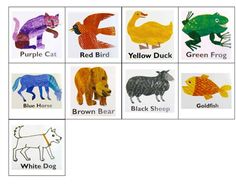A source of frustration for students who have limited language skills can be, for lack of a better word, a fear of the unknown. A student with poor receptive and expressive language can have difficulty knowing what's coming next, or when they should be engaging in a certain activity. To overcome this obstacle, many educators utilize a visual schedule, typically individualized to the student's needs/abilities. Something that comes up with the students in our classroom is difficulty with the weekends, or vacations, whenever there is a long break from school. It is hard to tell if our students have an understanding of weekends, holidays, when there is school and when there is no school. To help with this abstract concept- we can use PECS.
You can use the PECS pictured above to create a weekly calendar for a student. Laying out the days of the week (Su M Tu W Th F Sa) on the top row, and printing out additional copies of the "school" and "home" icons, and lining the bottom row with the appropriate icon. The "holiday" icon can be utilized here if there is a long weekend or holiday that week. Then, in reviewing the schedule with your student, you can use the visuals to help better embed the idea of "home days" vs. "school days" to the student. This is a helpful tool for parents in the home setting as well as educators in the school setting.
USING PECS IN THE CLASSROOM
A blog with information about Picture Exchange Communication Systems and the effect on communication for students with developing language.
Friday, July 17, 2015
Brown Bear, Brown Bear Lesson
"Brown Bear, Brown Bear" by Bill Martin Jr/Eric Carle (Pictured below) is a simple children's book with repeating language and colorful illustrations, making for a great lesson plan for children with emerging literacy skills.
A deficit within our classrooms today is not always being able to modify curriculum for all learners to be able to participate. Using PECS, and books with repeating language, such as "Brown Bear, Brown Bear" - teachers can create a lesson plan that can be individualized to any student. While most students participating in a reading activity with this book may catch on to the repeating phrase (in this case- "Brown bear, brown bear, what do you see?") and verbally repeat it, showing understanding of the rhythm and flow of the story, some students may need accommodations to participate. Students who are non-verbal, or have emerging language skills may have difficulty with this type of lesson, which is where teachers can use PECS.
The PECS board pictured above can be an attractive alternative to a teacher with a student who is non-verbal, the student can utilize this PECS board by pointing to the corresponding image as the class is verbalizing the sentence. Additionally, teachers may also want to use a PECS board with all of the animals printed on it (see below), so the student is able to choose which picture corresponds to the correct page being read.
A deficit within our classrooms today is not always being able to modify curriculum for all learners to be able to participate. Using PECS, and books with repeating language, such as "Brown Bear, Brown Bear" - teachers can create a lesson plan that can be individualized to any student. While most students participating in a reading activity with this book may catch on to the repeating phrase (in this case- "Brown bear, brown bear, what do you see?") and verbally repeat it, showing understanding of the rhythm and flow of the story, some students may need accommodations to participate. Students who are non-verbal, or have emerging language skills may have difficulty with this type of lesson, which is where teachers can use PECS.
The PECS board pictured above can be an attractive alternative to a teacher with a student who is non-verbal, the student can utilize this PECS board by pointing to the corresponding image as the class is verbalizing the sentence. Additionally, teachers may also want to use a PECS board with all of the animals printed on it (see below), so the student is able to choose which picture corresponds to the correct page being read.
This activity can be used as a way for students who are non-verbal to show their understanding of emerging literacy skills. These PECS boards are often used as a stepping stone for students, and can be used when moving towards an AAC device. In which case, a text-to-speech device with these PECS on it is also a nice way to include learners who are non-verbal in the classroom setting.
Subscribe to:
Comments (Atom)



